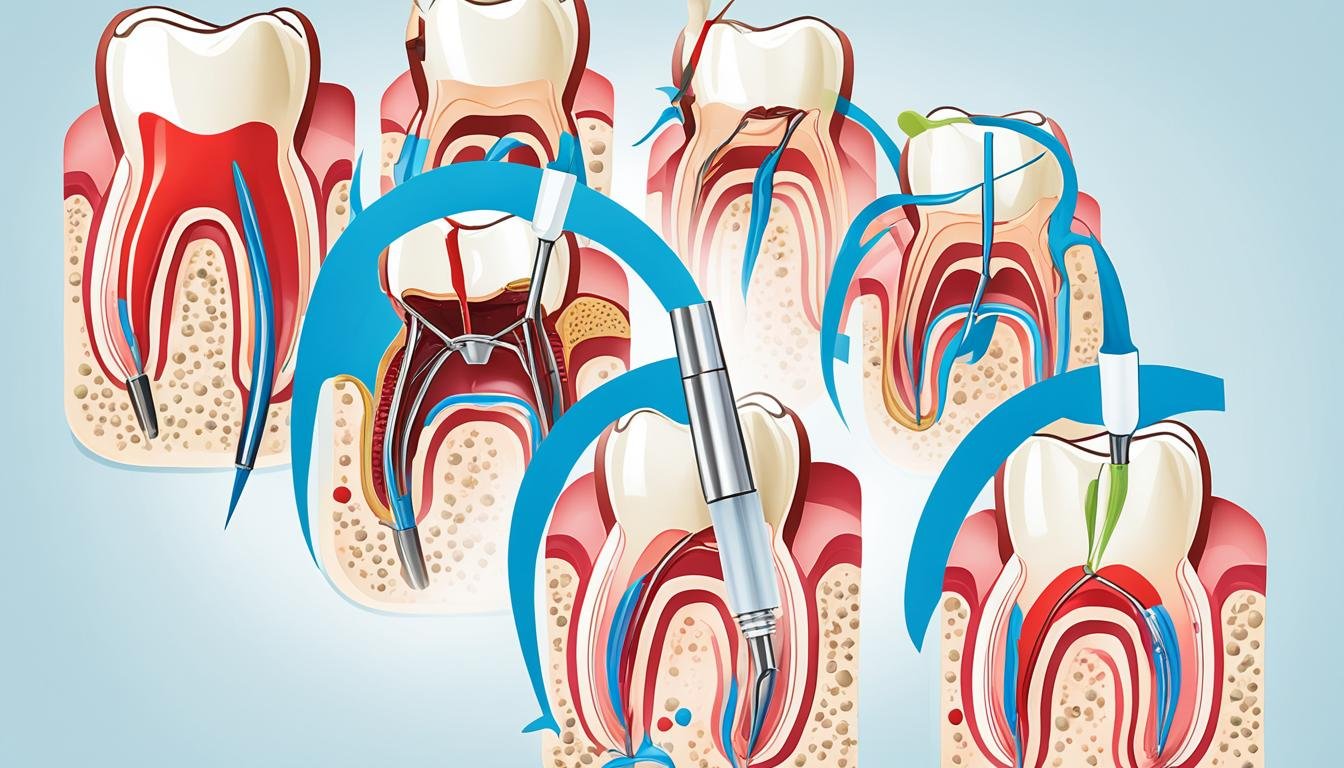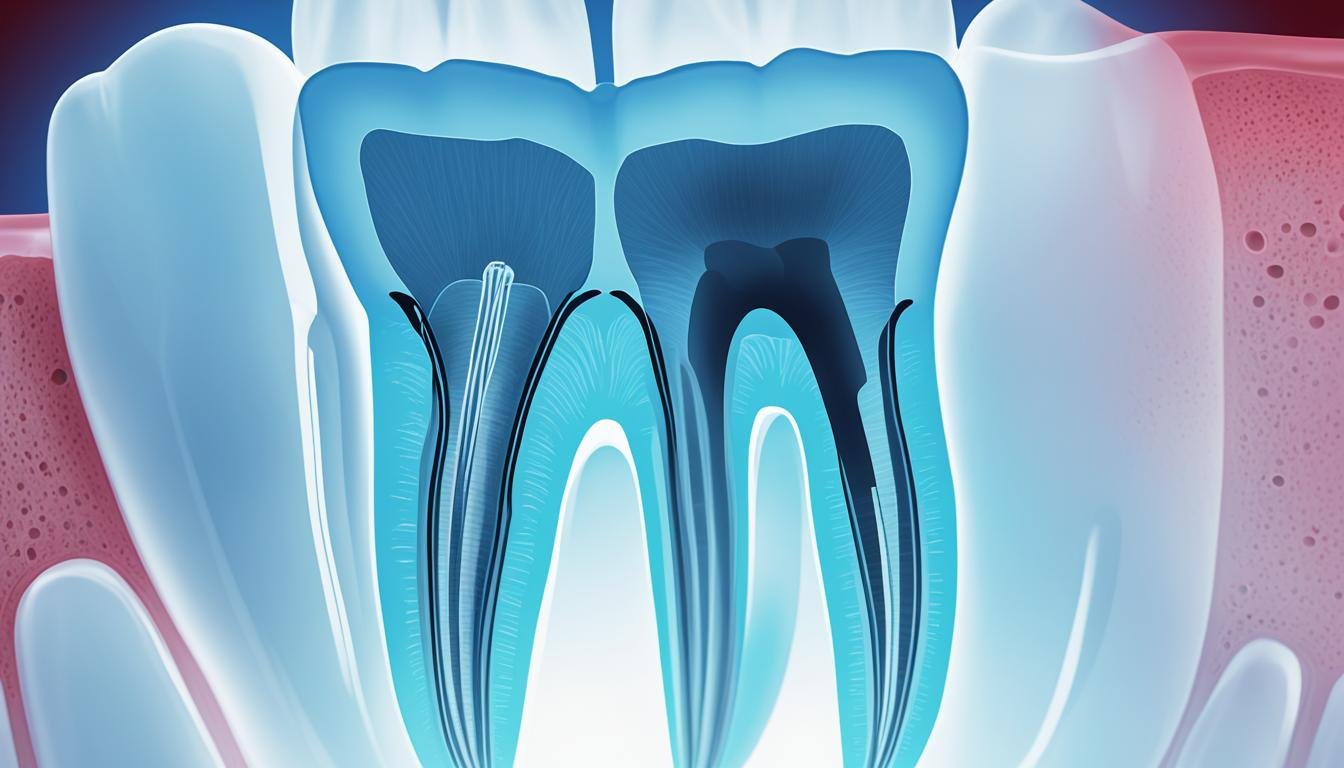Did you know over 15 million root canals are done each year in the US? If you have pain or decay in your front teeth, you’re in good company. We’ll answer common questions about root canal treatment for these teeth. From the procedure to the cost, recovery, and other options, we have all the info.
Key Takeaways:
- Root canal treatment is a common procedure for front teeth, with over 15 million procedures performed annually in the United States.
- This article answers frequently asked questions about root canal treatment for front teeth, including the procedure, cost, recovery, and alternatives.
- Understanding the options available can help you make informed decisions about your dental health and preserving your smile.
- Consult with a qualified dentist for personalized advice and recommendations based on your specific case.
- Proper care and maintenance can ensure the long-term success of a front tooth root canal and prevent future issues.
What is a root canal treatment?
A root canal treatment is a dental procedure. It removes bad pulp from a tooth and seals it. This stops more infection or decay. It’s often done on front teeth hit by decay, trauma, or issues.
To get how it works, knowing a tooth’s structure helps. Inside every tooth is soft pulp, having blood vessels, nerves, and tissue. When this pulp gets bad, it brings pain, sensitivity, and troubles.
In this treatment, the dentist gets to the pulp chamber. They take out the bad pulp with special tools. Doing this gets rid of the infection and eases pain.
After removing the pulp, the dentist cleans and shapes the canals. They do this to make sure nothing bad is left. Then, they fill the canals with a material called gutta-percha. This stops bacteria from coming back.
Next, the dentist puts on a temporary or permanent cover. This could be a crown or filling. It looks natural and makes the tooth strong again.
Benefits of a front tooth root canal treatment:
- It keeps your natural tooth.
- It stops pain and discomfort.
- It keeps more infection or decay away.
- It brings back looks and use.
A root canal for a front tooth can save the tooth and make your smile bright again. It’s best to talk to a dentist to see what you need.
Why would I need a root canal for a front tooth?
We all want our front teeth to look and work great. Sometimes, a root canal is needed to fix and save a tooth. Let’s see why you might need this for a front tooth.
- Severe Decay: Front teeth can get cavities because they are used a lot. If a cavity goes deep, a root canal may remove the bad parts.
- Infection: Cavities or injuries that aren’t treated can infect a tooth’s center. A root canal gets rid of the infection.
- Trauma: Injuries can harm front teeth. A big hit can hurt the inside, needing a root canal to fix it.
- Cracks in the Tooth: Cracks can make front teeth weak and sick. A root canal can fix these cracks.
Getting a root canal can stop pain, save your tooth, and keep your smile looking good.
“A root canal treatment for a front tooth is like giving it a second chance to shine. It saves the tooth from extraction and allows us to restore not just its functionality but also its aesthetic appeal.”
| Advantages of Front Tooth Root Canal | Disadvantages of Front Tooth Root Canal |
|---|---|
|
|
You should talk to a good dentist to check your front tooth. They will see how bad the damage is and if a root canal is best for you.
How does a front tooth root canal procedure work?
We are going to learn how a front tooth root canal is done. Knowing how it works can make you feel better and ready for your dentist visit.
Step 1: Diagnosis and Preparation
First, your dentist checks your tooth and takes X-rays. This helps find the problem and plan the treatment. Your dentist will talk about the steps and answer your questions.
Step 2: Local Anesthesia
Your dentist will numb your tooth area with medicine. This makes sure you don’t feel pain during the treatment. If you’re really worried or sensitive to pain, your dentist might offer extra help to relax you.
Step 3: Accessing the Tooth
After your tooth is numb, your dentist makes a small hole. This hole helps the dentist get to the bad pulp inside.
Step 4: Cleaning and Shaping the Root Canals
Your dentist uses special tools to clean and shape the canals inside your tooth. They remove all the bad stuff. The canals are also shaped for the filling.
Step 5: Filling the Canals and Sealing the Tooth
Then, your dentist fills the canals with a safe material called gutta-percha. This keeps away future infections. Sometimes, a temporary filling is used till the next visit.
Step 6: Restoring the Tooth
After the root canal, your tooth needs to be fixed to stay strong and look good. Your dentist might suggest a crown or another option to make your tooth look natural again.
| Benefits of Front Tooth Root Canal Procedure | Considerations |
|---|---|
|
|
What can I expect during a front tooth root canal treatment?
Getting a root canal on a front tooth is common. It helps with pain and keeps your smile. Your dentist will take steps to make sure you don’t feel pain. They use numbing techniques for your comfort.
Managing pain is key in root canal treatments. Your dentist will use anesthesia to numb the tooth. This means you won’t feel pain while they work.
Sometimes, you might get laughing gas or sedation. These methods help you stay calm and relaxed.
Your dentist will remove bad pulp from your tooth. It’s important to stop infection and protect your tooth. Then, they clean and seal the root canals with a safe material.
Your dental team will make sure you are comfortable. They support you and answer any questions. Talking with your dentist helps a lot.
Now, here’s a step-by-step of what happens:
- Anesthesia administration: First, local anesthesia makes sure you don’t feel pain.
- Pulp removal: Your dentist takes out the bad pulp with special tools.
- Canal cleaning: They clean the canals well to remove all bacteria.
- Root canal filling: Canals are filled with a safe material called gutta-percha.
- Tooth restoration: You get a temporary filling or crown for now.
Your dentist keeps you comfortable and adjusts as needed. Make sure to follow their advice after.
“We focus on a pain-free root canal. We use modern ways to manage pain. Our goal is to save your tooth and care for you.” – Dr. Emily Johnson, DDS
Knowing what happens helps you feel ready for your root canal. Remember, your dentist will customize your treatment.

How long does it take to recover from a front tooth root canal?
Recovery time from a front tooth root canal can vary. The procedure usually takes one to two hours. But getting fully better can take days to weeks. You might feel discomfort or sensitivity.
For a smooth recovery, listen to your dentist’s advice. You might need to take pain medicines or antibiotics. Be sure to brush well. Also, stay away from hard or sticky foods to avoid damage.
If pain or swelling gets bad, call your dentist right away. They can check and help fix any problems. This will help you heal the right way.
Each person’s recovery from a front tooth root canal is different. Taking good care of your tooth is key. Make sure to keep your mouth clean. Also, see your dentist regularly for a good healing process.
What are the alternatives to a front tooth root canal?
There are other ways to fix dental problems besides a front tooth root canal. These methods can keep your smile bright and your tooth working right without a root canal.
Dental Extractions
Sometimes, taking out a tooth is better than a root canal. This means removing the bad tooth. Then, you can get a dental implant or bridge.
Dental extractions are for when a tooth is too damaged for a root canal.
Dental Implants
Dental implants are a lasting way to replace a missing front tooth. A titanium implant is put into the jawbone. It holds a dental crown.
Implants make your smile look good again. They also work well and stay put, making them a great choice instead of a root canal.
Bridges
Bridges are another option instead of a root canal. They fix your smile and tooth’s job.
They use two crowns on teeth next to the empty space. These crowns hold an artificial tooth in the gap. This fixes your smile and how you use your tooth without a root canal.
How much does a front tooth root canal cost?
The cost of fixing a front tooth with a root canal varies. It depends on a few things.
The cost changes based on how bad the problem is and where the dentist is. If you have dental insurance, it can also affect the price.
Your dentist will look at your tooth to see what it needs. This helps them figure out how much it will cost.
There might be extra costs for other services. Like X-rays or follow-up visits.
Dental insurance can help pay for some of the cost. But every insurance is different. Make sure you know what yours covers.
If you don’t have insurance, ask your dentist about payment plans. Some dentists work with companies that help you pay over time.
Taking care of your teeth is important. Do not wait to get a root canal if you need one. It could cause more problems and cost more later.
Factors Influencing Front Tooth Root Canal Costs
| Factors | Impacts on Cost |
|---|---|
| Severity of the issue | A more severe condition may require additional treatment steps and materials, leading to higher costs. |
| Location of the dental clinic | Dental practices in different areas may have varying costs of living, rent, and overhead expenses, which can affect the treatment price. |
| Dental insurance coverage | Insurance plans can help reduce out-of-pocket expenses for root canal treatments. Coverage levels, deductibles, and co-pays may impact the final cost. |
| Additional treatments | In some cases, additional procedures such as dental crowns or fillings may be necessary after the root canal, adding to the overall cost. |
Can I return to my daily activities after a front tooth root canal?
After a front tooth root canal, you may wonder when to get back to daily tasks. Knowing when it’s safe to do regular things is key.
1. Rest and Relaxation
Resting after your root canal is vital. You can do light stuff in a day or two. Just avoid hard exercise at first.
2. Oral Hygiene Practices
Good oral care helps you heal fast. Use a soft toothbrush gently. Be gentle with your front tooth.
3. Dietary Considerations
After the procedure, avoid hard or crunchy food. Choose soft foods to eat at first.
Did You Know? Following your dentist’s advice helps you recover smoothly.
4. Follow-up Appointments
Seeing your dentist after is important. They check your healing and give more help.
5. Be Mindful of Discomfort
Mild pain after is normal. Painkillers can help, but ask your dentist first.
These tips will help you get back to normal after your root canal. Always check with your dentist if you’re unsure.

Is a front tooth root canal painful?
Many people worry about pain with a front tooth root canal. But, dental work has improved a lot. Now, it’s much easier for patients.
Your dentist will make the area numb before starting. They use local anesthesia. This way, you won’t feel any pain.
Sometimes, dentists offer more help for those who feel very nervous. Always talk to your dentist if you’re worried. They want to make you feel safe and comfortable.
Most say a front tooth root canal feels like getting a filling. It’s not too bad. Remember, everyone feels pain differently.
Testimonial:
“I was scared of the pain before my root canal. But my dentist was so careful. With anesthesia, I felt nothing. I was so glad to get rid of my tooth pain without hurting.” – Sarah, Happy Patient
A front tooth root canal stops tooth pain. Dentists who do this care a lot about making you comfortable. They are very skilled.
How to find the best front tooth root canal specialist?
Finding a great front tooth root canal specialist is key for your mouth’s health. You might need one for decay, infection, or an injury. Picking the right expert ensures a good result. Here are some tips to help you find them:
- Seek Recommendations: Ask your dentist who they suggest. They know many specialists.
- Check Credentials: Look for specialists with extra training in front tooth root canals. Make sure they have good credentials and are part of professional groups.
- Read Reviews: Go online to see what others say about the specialists. Good reviews mean they’re likely skilled and treat patients well.
- Consider Accessibility: Think about where they’re located. It’s better if they’re not too far from you.
- Schedule Consultations: Talk to a few top specialists. Ask them about their work and plans. Choose someone who makes you feel comfortable.
Taking your time to find the right specialist is important. Do your research and go with your gut. With the right expert, your smile will be as good as new.
“Choosing the right front tooth root canal specialist can make all the difference in your treatment experience and outcome.” – Dr. Sarah Thompson, DDS
Key Considerations for Finding the Best Front Tooth Root Canal Specialist
| Consideration | Description |
|---|---|
| Recommendations | Ask your dentist for referrals to reputable specialists. |
| Credentials | Verify the specialist’s training, certifications, and professional affiliations. |
| Reviews | Read patient reviews and testimonials to gauge the specialist’s reputation. |
| Accessibility | Consider the location and convenience of the specialist’s practice. |
| Consultations | Meet with potential specialists to ask questions and assess their approach. |
By using these tips and doing your homework, you’ll find a great front tooth root canal expert. They’ll give you the amazing care you need.
Is a front tooth root canal a permanent solution?
A front tooth root canal treats dental issues effectively. It focuses on the tooth’s root canal system.
The process includes removing the bad pulp. The dentist cleans and seals the roots.
It stops the pain and saves the tooth. Your smile and bite stay natural.
Root canal therapy fixes the root cause. It gets rid of the infection and stops future problems.
The Importance of Proper Care and Maintenance
Care is key even after a front tooth root canal. Brush, floss, and see your dentist regularly.
Wear a mouthguard during sports to protect your teeth. It helps avoid more damage.
| Benefits of a Front Tooth Root Canal |
|---|
| 1. Preserves the natural tooth |
| 2. Eliminates tooth pain and discomfort |
| 3. Restores proper tooth function |
| 4. Prevents the need for tooth extraction |
| 5. Enhances your smile and self-confidence |
Take good care of your tooth post-root canal. Enjoy a lasting and healthy solution.
A front tooth root canal keeps your natural tooth safe. With care, enjoy a healthy smile for long.
Conclusion
This article talked about root canal treatment for front teeth. You learned about the process, costs, how to recover, and other choices. It’s key to talk to a good dentist if you want help that fits just you.
Getting a root canal on a front tooth can fix decay, infection, and damage. It saves your natural tooth, which keeps its look and use. Healing after getting a front tooth root canal usually goes well. Listen to your dentist to heal fast.
Your dentist will make a treatment plan just for you. If you’re worried or have questions, talk to a front tooth root canal specialist. They will help you get the best care as you go through your root canal.

